A Critical Review of Pavement Design Methods Based on a Climate Approach
Abstract
:1. Introduction
- (a)
- Structural. These include characteristics related to each of the layers that compose the road pavement, such as thickness, strength, and deformability in the expected service conditions. This relates to the materials that conform to the structure and the stresses required for the design.
- (b)
- Traffic load. This refers to the effects produced by mixed traffic as it travels along the road. In this case, data related to Annual Average Daily Traffic (AADT), annual growth rate, single or tandem axle loads, histogram of traffic distribution in the road section, and pavement design life before the road requires reconstruction in years, in which case the pavement failure criterion must be defined in advance. The mixed traffic should be transformed into equivalent traffic on single axles using theoretical-empirical factors. New approaches use load spectra to characterize traffic more accurately.
- (c)
- Climate and regional conditions. The rheological characteristics of the materials that constitute the road depend on the temperature, precipitation regime, average annual precipitation, water table, geology, and topography of the region.
2. Review of Flexible Pavement Design Methods
2.1. Early Pavement Design Methods
2.2. New Approaches for Pavement Design
3. Climate Considerations in Pavement Design Methods
3.1. First Approaches That Included or Considered Climate in Pavement Design
3.2. Incorporating Climate Factors in Pavement Design
4. Analysis of Pavement Design Methods
4.1. Climate-Related Factors Used in Pavement Design Methods
4.2. Key Findings from the Analysis of Pavement Design Methods
4.3. Climate Change in Pavement Design Methods
4.4. Relevance of This Review
5. Conclusions
Author Contributions
Funding
Institutional Review Board Statement
Informed Consent Statement
Data Availability Statement
Acknowledgments
Conflicts of Interest
References
- Plati, C. Sustainability factors in pavement materials, design, and preservation strategies: A literature review. Constr. Build. Mater. 2019, 211, 539–555. [Google Scholar] [CrossRef]
- Scala, A.J. Environmental factors in flexible pavement design. In Flexible Pavement Design Proceedings; Paper no. 66; Australian Road Research Board: Canberra, Australia, 1962. [Google Scholar]
- Mills, B.; Tighe, S.; Andrey, J.; Huen, K.; Parm, S. Climate change and the performance of pavement infrastructure in southern Canada: Context and case study. In Proceedings of the IEEE EIC Climate Change Conference, Ottawa, ON, Canada; 2006; pp. 1–9. [Google Scholar] [CrossRef]
- Highway Research Board. Review of Existing Theories and Methods of Pavement Design; Highway Research Circular No. 112; National Academy of Sciences—National Research Council: Washington, DC, USA, 1970. [Google Scholar]
- Haas, R.; Hudson, W.R.; Zaniewski, J. Modern Pavement Management; Krieger Publishing Company: Malabar, FL, USA, 1994. [Google Scholar]
- Huang, Y.H. Pavement Analysis and Design, 2nd ed.; Pearson Prentice Hall: Upper Saddle River, NJ, USA, 2004; ISBN 0-13-142473-4. [Google Scholar]
- Haas, R. Reinventing the (pavement management) wheel. Distinguished lecture. In Proceedings of the Fifth International Conference on Managing Pavements, Seattle, WA, USA, 11–14 August 2001. [Google Scholar]
- Corro Caballero, S.; Prado Ollervide, G. Diseño Estructural de Carreteras con Pavimento Flexible; Series del Instituto de Ingeniería No. 325; UNAM: México, Mexico, 1974. [Google Scholar]
- Schwartz, C.W.; Carvalho, R.L. Implementation of the NCHRP 1-37A design guide. In Volume 2: Evaluation of Mechanistic-Empirical Design Procedure; University of Maryland, Maryland State Highway Administration: Baltimore, MD, USA, 2007. [Google Scholar]
- Ali, H.A.; Lopez, A. Statistical Analyses of Temperature and Moisture Effects on Pavement Structural Properties Based on Seasonal Monitoring Data. Transp. Res. Rec. J. Transp. Res. Board 1996, 1540, 48–55. [Google Scholar] [CrossRef]
- Wistuba, M.P.; Walther, A. Consideration of climate change in the mechanistic pavement design. Road Mater. Pavement Des. 2013, 14 (Suppl. 1), 227–241. [Google Scholar] [CrossRef]
- Zhao, X.; Shen, A.; Ma, B. Temperature response of asphalt pavement to low temperatures and large temperature differences. Int. J. Pavement Eng. 2020, 21, 49–62. [Google Scholar] [CrossRef]
- Din, I.M.U.; Mir, M.S.; Farooq, M.A. Effect of Freeze-Thaw Cycles on the Properties of Asphalt Pavements in Cold Regions: A Review. Transp. Res. Procedia 2020, 48, 3634–3641. [Google Scholar] [CrossRef]
- Lu, D.; Tighe, S.L.; Xie, W.-C. Impact of flood hazards on pavement performance. Int. J. Pavement Eng. 2018, 21, 746–752. [Google Scholar] [CrossRef]
- Wang, W.; Wang, L.; Miao, Y.; Cheng, C.; Chen, S. A survey on the influence of intense rainfall induced by climate warming on operation safety and service life of urban asphalt pavement. J. Infrastruct. Preserv. Resil. 2020, 1, 4. [Google Scholar] [CrossRef]
- Dan, H.-C.; Xin, P.; Li, L.; Lockington, D. Capillary effect on flow in the drainage layer of highway pavement. Can. J. Civ. Eng. 2012, 39, 654–666. [Google Scholar] [CrossRef]
- Yu, H.; Bai, X.; Qian, G.; Wei, H.; Gong, X.; Jin, J.; Li, Z. Impact of Ultraviolet Radiation on the Aging Properties of SBS-Modified Asphalt Binders. Polymers 2019, 11, 1111. [Google Scholar] [CrossRef]
- Li, Y.; Feng, J.; Wu, S.; Chen, A.; Kuang, D.; Bai, T.; Gao, Y.; Zhang, J.; Li, L.; Wan, L.; et al. Review of ultraviolet ageing mechanisms and anti-ageing methods for asphalt binders. J. Road Eng. 2022, 2, 137–155. [Google Scholar] [CrossRef]
- Zapata, C.E.; Andrei, D.; Witczak, M.W.; Houston, W.N. Incorporation of Environmental Effects in Pavement Design. Road Mater. Pavement Des. 2007, 8, 667–693. [Google Scholar] [CrossRef]
- Qiao, Y.; Santos, J.; Stoner, A.M.; Flinstch, G. Climate change impacts on asphalt road pavement construction and maintenance: An economic life cycle assessment of adaptation measures in the State of Virginia, United States. J. Ind. Ecol. 2020, 24, 342–355. [Google Scholar] [CrossRef]
- Ankit, G.; Kumar, P.; Rastogi, R. Effect of Environmental Factors on Flexible Pavement Performance Modeling. In Proceedings of the 8th International Conference on Managing Pavement Assets, Santiago, Chile, 15–19 November 2011. [Google Scholar]
- Porter, O.J. Development of CBR Flexible Pavement Design Method for Airfields: A Symposium: Development of the Original Method for Highway Design. Proc. Am. Soc. Civ. Eng. 1949, 75, 11–17. [Google Scholar]
- Davis, W.C.; Jones, W.G. Flexible-Pavement Design by the Group Index Method; Missouri State Highway Department, Division of Materials: New Florence, MO, USA, 1954. [Google Scholar]
- Barber, E.S. Application of Triaxial Compression Test Results to the Calculation of Flexible Pavement Thickness; Proceedings Highway Research Board: Washington, DC, USA, 1946; Volume 26. [Google Scholar]
- Terzaghi, K. Theoretical Soil Mechanics; John Wiley & Sons, Inc.: Hoboken, NJ, USA, 1943; ISBN 9780470172766. [Google Scholar]
- McDowell, C. Triaxial Tests in Analysis of Flexible Pavements. Texas Highway Department. Highway Research Board. Research Report 16b-001. 1954. Available online: http://onlinepubs.trb.org/Onlinepubs/hrbresearchrpts/1954/16b-001.pdf (accessed on 15 December 2022).
- Palmer, L.A.; Barber, E.S. Soil displacement under a circular loaded area. Proc. Highw. Res. Board 1940, 20, 279–286. [Google Scholar]
- State Highway Commission of Kansas. Design of Flexible Pavement Using the Triaxial Compression Test; Bulletin No. 8; Highway Research Board: Washington, DC, USA, 1947. [Google Scholar]
- Corté, J.-F.; Goux, M.-T. Design of Pavement Structures: The French Technical Guide. Transp. Res. Rec. J. Transp. Res. Board 1996, 1539, 116–124. [Google Scholar] [CrossRef]
- Shell International Petroleum Company, Ltd. Design Charts for Flexible Pavements; Fifth Reprint; Shell International Petroleum Company, Ltd.: London, UK, 1977. [Google Scholar]
- Shell International Petroleum Company, Ltd. Shell Pavement Design Manual: Asphalt Pavements and Overlays for Road Traffic; Shell International Petroleum Company, Ltd.: London, UK, 1978. [Google Scholar]
- American Association of State Highway Officials. AASHO Interim Guide for Design of Pavement Structures; American Association of State Highway Officials: Washington, DC, USA, 1961. [Google Scholar]
- American Association of State Highway and Transportation Officials (AASHTO). Guide for Design of Pavement Structures; American Association of State Highway and Transportation Officials (AASHTO): Washington, DC, USA, 1986. [Google Scholar]
- American Association of State Highway and Transportation Officials (AASHTO). Guide for Design of Pavement Structures; American Association of State Highway and Transportation Officials (AASHTO): Washington, DC, USA, 1993; ISBN 1-56051-055-2. [Google Scholar]
- Asphalt Institute. Thickness Design—Full Depth Asphalt Pavement Structures for Highways and Streets; Manual Series No. 1 (MS-1); Revised eight edition; Asphalt Institute: Lexington, KY, USA, 1970. [Google Scholar]
- Rauhut, J.B.; Gendeü, D.S. Proposed development of pavement performance prediction models from SHRP/LTPP Data. In Proceedings of the Second Northamerican Conference on Managing Pavements, Toronto, ON, Canada, 2–6 November 1987; Volume 2, pp. 221–237. [Google Scholar]
- Nikolaides, A.; Tsohos, G.; Papavasileiou, A. Pavement Design Guide. Submitted Report; Egnatia Odos S.A.: Thessaloniki, Greece, 1997. [Google Scholar]
- Nikolaides, A. Highway Engineering: Pavements, Materiales and Control of Quality; Taylor & Francis Group: Abingdon, UK, 2015; ISBN 13 978-1-4665-7997-2. [Google Scholar]
- Standards for Highways. CD 226 Design for New Pavement Construction. Design Manual for Roads and Bridges; Stationery Office: London, UK, 2021. [Google Scholar]
- Laboratoire Central des Ponts et Chaussees (LCPC) et Le Service D’etudes Tehniques des Routes et Autoroutes (SETRA). Conception de Dimensionnement des Structures de Chassées: Guide Technique National; Ministère de l’Equipement des Transports et du Tourisme: Paris, France, 1994. [Google Scholar]
- American Association of State Highway and Transportation Officials (AASHTO). Mechanistic-Empirical Pavement Design Guide. A Manual of Practice; American Association of State Highway and Transportation Officials (AASHTO): Washington, DC, USA, 2008; ISBN 978-1-56051-423-7. [Google Scholar]
- Mincad Systems Pty Ltd. CIRCLY Users’ Manual, Version 7.0; Mincad Systems Pty Ltd.: Richmond, Australia, 2022. [Google Scholar]
- IFSTTAR. ALIZE-LCPC. Software for Pavement Structures Analysis and Design. User Manual, Version 1.5. Available online: https://www.alize-lcpc.com/ (accessed on 13 November 2023).
- Indian Road Congress. Guidelines for the Design of Flexible Pavements; Fourth Revision; IRC: New Delhi, India, 2018. [Google Scholar]
- University of California—Davis. CalME: Caltrans Mechanistic-Empirical Structural Analysis Program for Flexible Pavements; University of California Pavement Research Center (UCPRC): Davis, CA, USA, 2020. [Google Scholar]
- Garnica, P.; Hernández, R.; Castellanos, A. El IMT-PAVE 3.0, Una Herramienta Para El Diseño Estructural de Pavimentos; No. 159, marzo-abril 2016, artículo 3; Boletín Notas del Instituto Mexicano del Transporte: México, Mexico, 2016. [Google Scholar]
- Arias Barrantes, E. Propuesta Para una Guía de Diseño Mecanística-Empírica para Pavimentos Flexibles y Semi-Rígidos de Costa Rica. Tesis; Universidad de Costa Rica: San Jose, CR, USA, 2020. [Google Scholar]
- Vásquez-Varela, L.R.; García-Orozco, F.J. UNLEA: A Multilayer Elastic Program Script in Scilab. In Proceedings of the International Airfield and Highway Pavements Conference, Chicago, IL, USA, 21–24 July 2019. Proceedings, 91–100. [Google Scholar] [CrossRef]
- Odemark, N. Lnvestigations on the Elastic Properties of Soils and the Design of Pavements according to the Theory of Elasticity; Statens Vaeginstitute: Stockholm, Sweden, 1949. [Google Scholar]
- Molenaar, A.A.; Van Gurp, C.A. Optimization of the thickness design of asphalt concrete. In Proceedings of the 10th Australian Road Research Board Conference, Sydney, Australia, 25–29 August 1980; Volume 10, pp. 31–44. [Google Scholar]
- Freeman, R.B.; Harr, M.E. Stress Predictions for Flexible Pavement Systems. J. Transp. Eng. 2004, 130, 495–502. [Google Scholar] [CrossRef]
- Ghanizadeh, A.R.; Ahadi, M.R. Application of Artificial Neural Networks for Analysis of Flexible Pavements under Static Loading of Standard Axle. Int. J. Transp. Eng. 2015, 3, 31–43. [Google Scholar] [CrossRef]
- Cho, Y.-H.; McCullough, B.F.; Weissmann, J. Considerations on Finite-Element Method Application in Pavement Structural Analysis. Transp. Res. Rec. J. Transp. Res. Board 1996, 1539, 96–101. [Google Scholar] [CrossRef]
- Transportation Research Board. Pavement Lessons Learned from the AASHO Road Test and Performance of the Interstate Highway System; Transportation Research Circular E-C118: Washington, DC, USA, 2007. [Google Scholar]
- Corro, S.; Magallanes, R.; Prado, G. Instructivo Para el Diseño Estructural de Pavimentos Flexibles Para Carreteras; Series del Instituto de Ingeniería No. 444; UNAM: México, Mexico, 1981. [Google Scholar]
- Secretaría de Integración Económica Centroamericana (SIECA). Manual Centroamericano Para el Diseño de Pavimentos; SIECA: Geneva, Switzerland, 2002. [Google Scholar]
- Asphalt Institute. Thickness Design—Asphalt Pavements for Highways and Streets, 9th ed.; Asphalt Institute: Lexington, KY, USA, 1999. [Google Scholar]
- Li, Q.; Mills, L.; McNeil, S. The Implications of Climate Change on Pavement Performance and Design; University of Delaware University Transportation Center (UD-UTC): Newark, DE, USA, 2011. [Google Scholar]
- Lytton, R.L.; Pufahl, D.E.; Michalak, C.H.; Liang, H.S.; Dempsey, B.J. An Integrated Model of the Climatic Effects on Pavements; Final Report. Report: FHWA-RD-90-033; Texas Transportation Institute, Texas A&M University: College Station, TX, USA; Federal Highway Administration: Washington, DC, USA, 1989. [Google Scholar]
- Solaimanian, M.; Bolzan, P. Analysis of the Integrated Model of Climatic Effects on Pavements; Strategic Highway Research Program: Washington, DC, USA, 1993. [Google Scholar]
- Larson, G.; Dempsey, B.J. Enhanced Integrated Climatic Model Version 2.0; Minnesota Department of Transportation Road Research Project. Final Report DTFA MN/DOT 72114; University of Illinois: Champaign, IL, USA, 1997. [Google Scholar]
- National Cooperative Highway Research Program (NCHRP). Calibration and Validation of the Enhanced Integrated Climatic Model for Pavement Design; The National Academies Press: Washington, DC, USA, 2008. [Google Scholar]
- California Department of Transportation (CalTrans). Analysis of 30 Years of Pavement Temperatures Using the Enhanced Integrated Climate Model (EICM); Pavement Research Center, University of California: San Diego, CA, USA, 2004. [Google Scholar]
- Rosenbalm, D. Reliability Associated with the Estimation of Soil Resilient Modulus at Different Hierarchical Levels of Pavement Design. Master’s Thesis, Arizona State University, Tempe, AZ, USA, 2011. [Google Scholar]
- Harvey, J.; Basheer, I. California’s Transition to Mechanistic-Empirical Pavement Design. Technol. Transf. Program 2011, 3, 1–12. [Google Scholar]
- Hosseini, F.; Nasimifar, M.; Sivaneswaran, N.; Golalipour, A. Mutual Impacts of Changing Climate and Flexible Pavement Performance Considering Resilience and Sustainable Aspects. J. Clean. Prod. 2024, 460, 142594. [Google Scholar] [CrossRef]
- Shell International Petroleum Company. The Shell Bitumen Handbook, 6th ed.; Hunter, R.N., Self, A., Read, J., Eds.; Published for Shell Bitumen by ICE Publishing: London, UK, 2015; ISBN 978-0-7277-5837-8. [Google Scholar]
- McCartney, J.S.; Selvam, R.P.; King, J.; Khosravi, A. Evaluation of the Enhanced Integrated Climatic Model for the Arkansas State Highway and Transportation Department; TRC0902, Final Report. 2010. Available online: https://www.ahtd.ar.gov/TRC/TRC%20Reports/TRC0902_Evaluation_of_the_Enhanced_Integrated_Climatic_Model_for_the_Arkansas_State_Highway_and_Transportation_Department.pdf (accessed on 8 January 2024).
- Taylor, M.A.; Philp, M.L. Investigating the impact of maintenance regimes on the design life of road pavements in a changing climate and the implications for transport policy. Transp. Policy 2015, 41, 117–135. [Google Scholar] [CrossRef]
- Mills, B.N.; Tighe, S.L.; Andrey, J.; Smith, J.T.; Huen, K. Climate Change Implications for Flexible Pavement Design and Performance in Southern Canada. J. Transp. Eng. 2009, 135, 773–782. [Google Scholar] [CrossRef]
- Meagher, W.; Daniel, J.S.; Jacobs, J.; Linder, E. Method for Evaluating Implications of Climate Change for Design and Performance of Flexible Pavements. Transp. Res. Rec. J. Transp. Res. Board 2012, 2305, 111–120. [Google Scholar] [CrossRef]
- Chinowsky, P.; Arndt, C. Climate Change and Roads: A Dynamic Stressor–Response Model. Rev. Dev. Econ. 2012, 16, 448–462. [Google Scholar] [CrossRef]
- Qiao, Y.; Dawson, A.R.; Parry, T.; Flintsch, G.; Wang, W. Flexible Pavements and Climate Change: A Comprehensive Review and Implications. Sustainability 2020, 12, 1057. [Google Scholar] [CrossRef]
- Gudipudi, P.P.; Underwood, B.S.; Zalghout, A. Impact of climate change on pavement structural performance in the United States. Transp. Res. Part D Transp. Environ. 2017, 57, 172–184. [Google Scholar] [CrossRef]
- Mallick, R.B.; Radzicki, M.J.; Daniel, J.S.; Jacobs, J.M. Use of System Dynamics to Understand Long-Term Impact of Climate Change on Pavement Performance and Maintenance Cost. Transp. Res. Rec. J. Transp. Res. Board 2014, 2455, 1–9. [Google Scholar] [CrossRef]
- Hasan, M.R.M.; Hiller, J.E.; You, Z. Effects of mean annual temperature and mean annual precipitation on the performance of flexible pavement using ME design. Int. J. Pavement Eng. 2016, 17, 647–658. [Google Scholar] [CrossRef]
- Li, Q.J.; Mills, L.; McNeil, S.; Attoh-Okine, N.O. Integrating potential climate change into the mechanistic–empirical based pavement design. Can. J. Civ. Eng. 2013, 40, 1173–1183. [Google Scholar] [CrossRef]
- Qiao, Y.; Flintsch, G.W.; Dawson, A.R.; Parry, T. Examining Effects of Climatic Factors on Flexible Pavement Performance and Service Life. Transp. Res. Rec. J. Transp. Res. Board 2013, 2349, 100–107. [Google Scholar] [CrossRef]
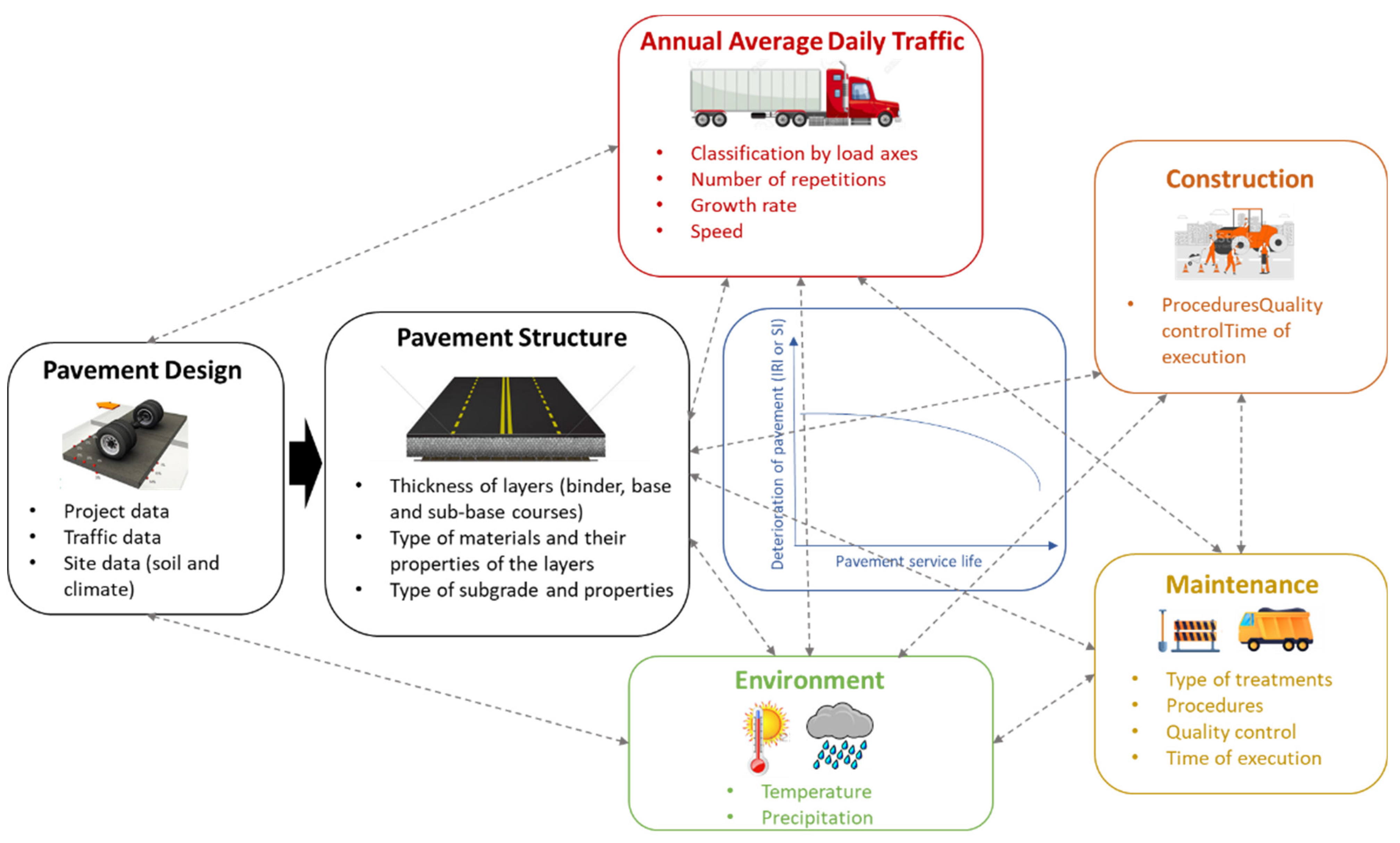
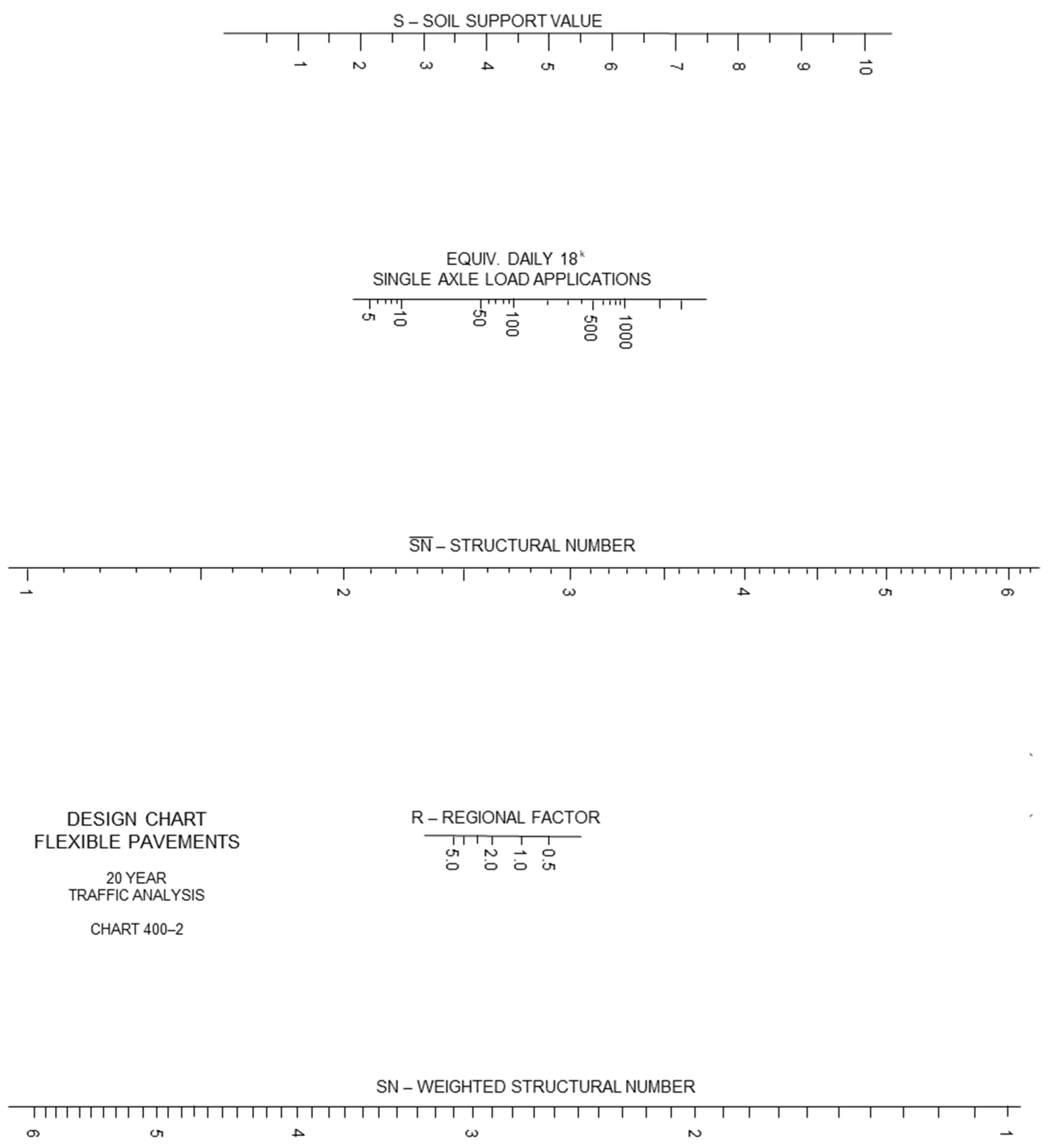


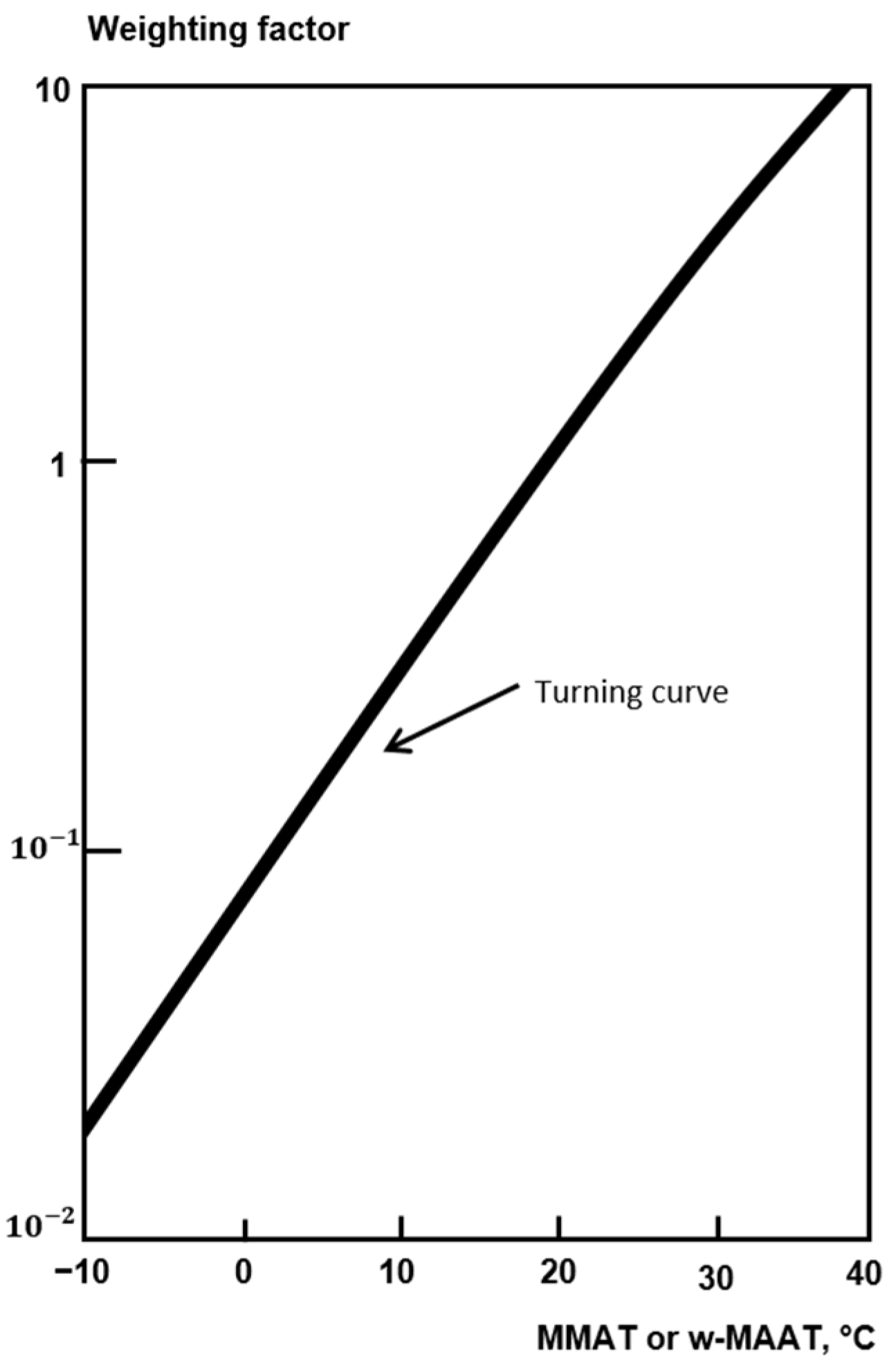
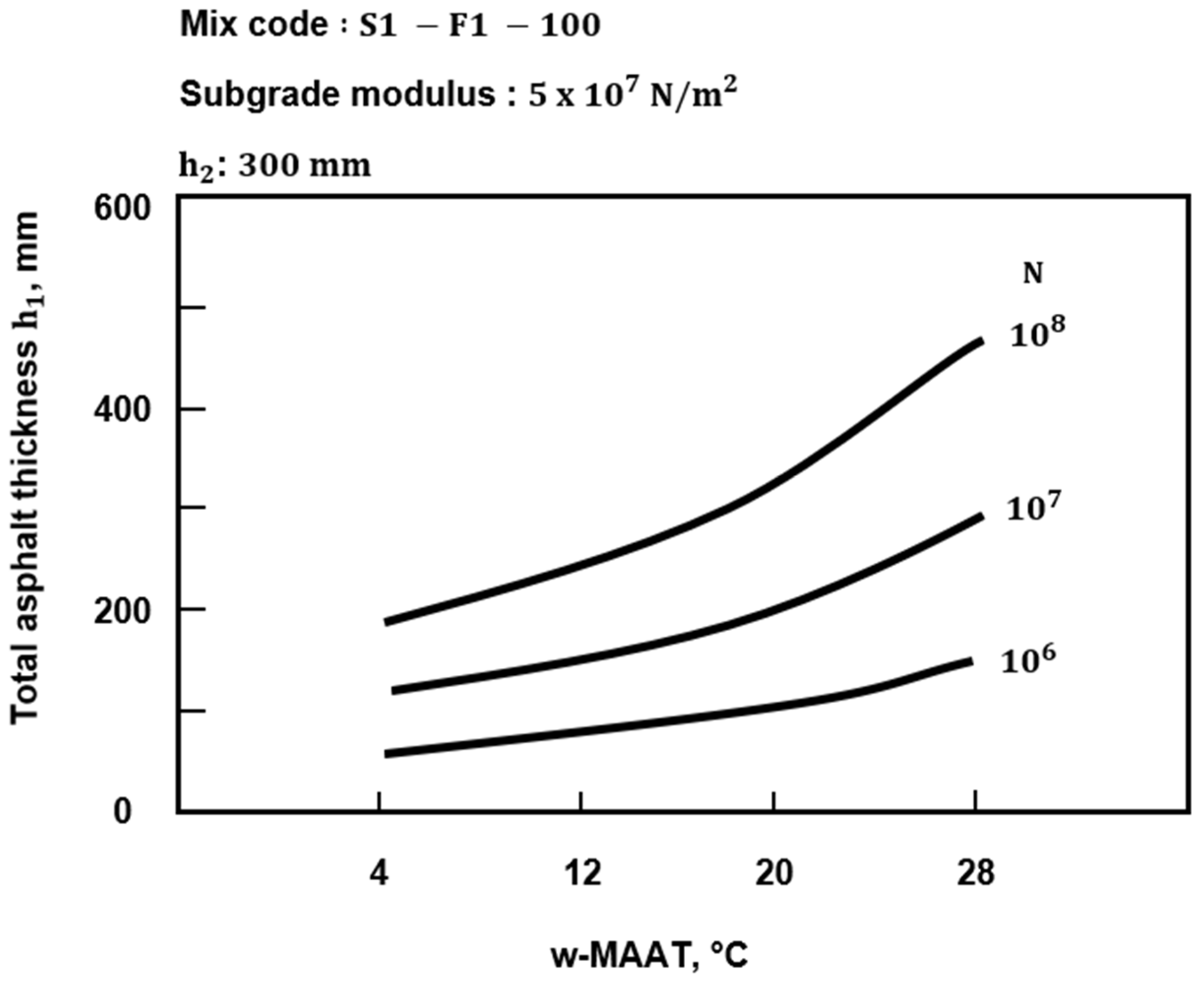
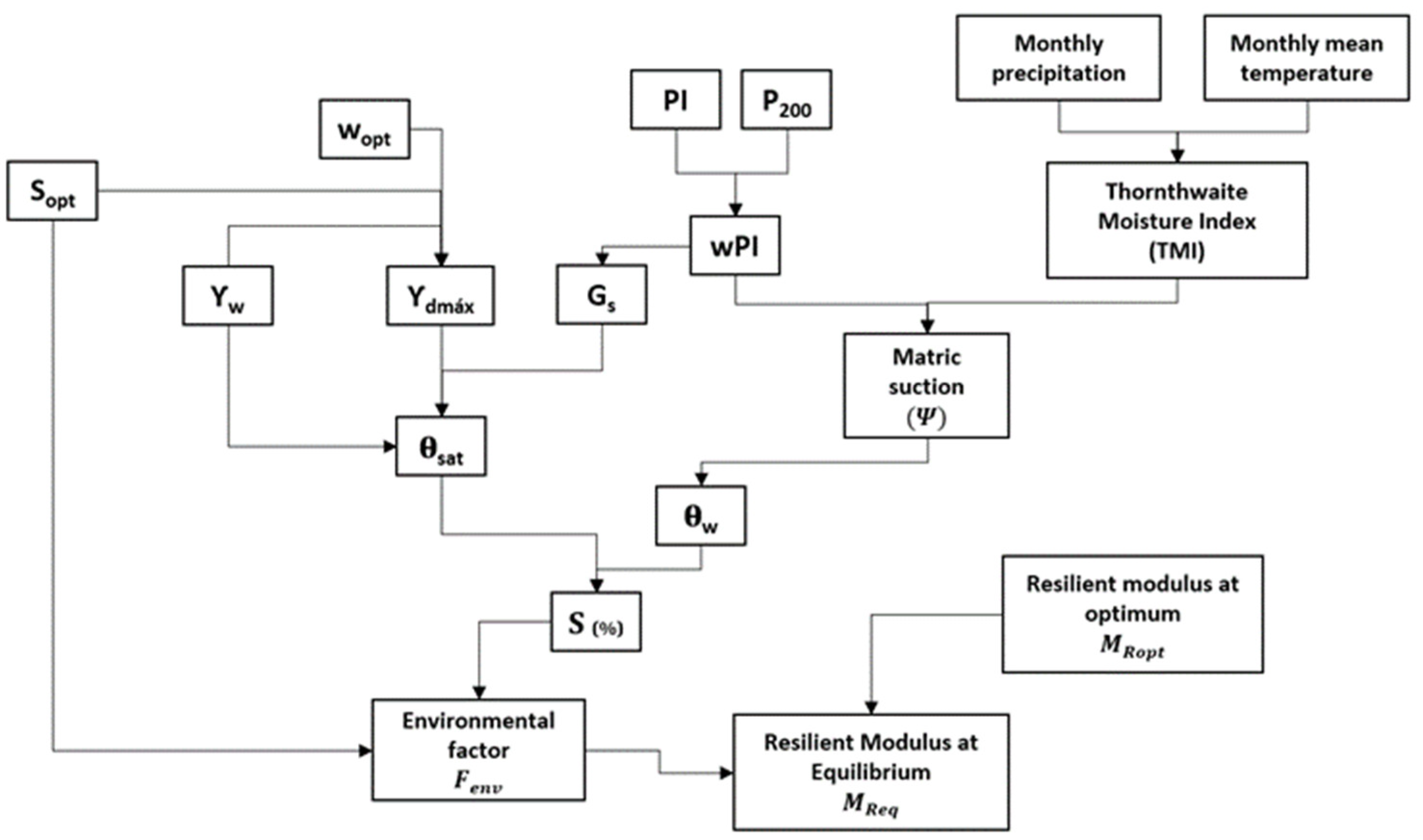
| Traffic Coefficient (m) | Wheel Load (lb) | Total Traffic (Veh Per Day) |
|---|---|---|
| 1 | 9000 | >1500 |
| 5/6 | 7500 | 900–1500 |
| 2/3 | 6000 | 300–900 |
| 1/2 | 4500 | 50–300 |
| Saturation Coefficient (n) | Average Annual Rainfall (in) |
|---|---|
| 1.0 | 35.0–45.0 |
| 0.9 | 30.0–34.9 |
| 0.8 | 25.0–29.9 |
| 0.7 | 20.0–24.9 |
| 0.6 | 15.0–19.9 |
| Quality of Drainage | Percent of Time Pavement Structure is Exposed to Moisture Levels Approaching Saturation | |||
|---|---|---|---|---|
| Less than 1% | 1–5% | 5–25% | Greater than 25% | |
| Excellent | 1.40–1.35 | 1.35–1.30 | 1.30–1.20 | 1.20 |
| Good | 1.35–1.25 | 1.25–1.15 | 1.15–1.00 | 1.00 |
| Fair | 1.25–1.15 | 1.15–1.05 | 1.00–0.80 | 0.80 |
| Poor | 1.15–1.05 | 1.05–0.80 | 0.80–0.60 | 0.60 |
| Very Poor | 1.05–0.95 | 0.95–0.75 | 0.75–0.40 | 0.40 |
| CBR | Number Equal to or Greater Than | Percent Equal to or Greater Than |
|---|---|---|
| 6 | 11 | (11/11) 100 = 100 |
| 7 | ||
| 7 | 10 | (10/11) 100 = 90.9 |
| 8 | 8 | (8/11) 100 = 72.7 |
| 9 | ||
| 9 | 7 | (7/11) 100 = 63.6 |
| 10 | ||
| 10 | 5 | (5/11) 100 = 45.4 |
| 11 | ||
| 11 | 3 | (3/11) 100 = 27.3 |
| 12 | 1 | (1/11) = 9.1 |
| Month | MMAT, °C | Chart W: Weighting Factor |
|---|---|---|
| January | 8 | 0.21 |
| February | 8 | 0.21 |
| March | 12 | 0.36 |
| April | 16 | 0.62 |
| May | 19 | 0.93 |
| June | 22 | 1.40 |
| July | 26 | 2.35 |
| August | 28 | 3.00 |
| September | 22 | 1.40 |
| October | 19 | 0.93 |
| November | 12 | 0.36 |
| December | 6 | 0.16 |
| Total of weighting factors | 11.93 | |
| Average of weighting factor | say 1.0 | |
| Chart W: w-MAAT, °C: | 19.5 say 20 | |
| Method | Design Principle | How Is Climate Included? | Key Factor |
|---|---|---|---|
| State Highway Commission of Kansas (1947) [28] | Limit deflection method | Consider soil saturation coefficient as a function of average annual rainfall. | Modulus of deformation of subgrade or subbase |
| AASHO method (1961) [32] | Regression methods based on road test | The structural number is adjusted for a regional factor due to climate. | Weighted Structural Number |
| AASHTO method (1986, 1993) [33,34] | Regression methods based on road test | The guide introduced the “Effective Resilient Modulus” of the roadbed soil, considering seasonal modulus to quantify the relative damage subjected to moisture changes. | Subgrade Resilient Modulus |
| AASHTO method (1986, 1993) [33,34] | Regression methods based on road test | Also includes a “Drainage Coefficient” for modifying structural layer coefficients of untreated base and subbase materials in pavements. | Structural layer coefficients |
| Asphalt Institute’s method (1970) [35] | Limit elastic strains | Consider environmental conditions that adversely affect the bearing properties of subgrade materials. | Subgrade bearing capacity ratio (CBR) |
| UNAM method (1974) [8,55] | Regression methods based on road test | Considers that climate conditions influence the bearing capacity of the soil (VRS). | Subgrade bearing capacity ratio (CBR) |
| Asphalt Institute’s method (1999) [57] | Limit elastic strains | Simulate the effects of temperature over time (seasonal variation) was based on a study relating modulus-temperature and asphalt properties. The temperature is used in charts to determine the asphalt layer thicknesses | Dynamic modulus of HMA |
| Shell method (1978) [31] | Limit elastic strains | Considers temperature variation in the properties of asphalt. Introduced “Weighted Mean Annual Air Temperature” (w-MAAT). The value of w-MAAT is used in charts to determine the asphalt layer thicknesses. | Dynamic modulus of HMA |
| LCPC & SETRA (1994) [40] | Rational design | Considers in its design environmental information as relevant: the hydric condition of the support soil, seasonal temperature cycles, and the intensity of frost periods. | Soil elastic modulus |
| AASHTO (2008) [41] | Mechanistic–Empirical | Include temperature and precipitation as environmental variables through the EICM, using the TMI. | Subgrade Resilient Modulus |
| AASHTO (2008) [41] | Mechanistic–Empirical | Temperatures of each HMA layer are combined into five quintiles. The average temperature within each quintile of a layer for each month is used to determine the dynamic modulus | Dynamic modulus of HMA |
Disclaimer/Publisher’s Note: The statements, opinions and data contained in all publications are solely those of the individual author(s) and contributor(s) and not of MDPI and/or the editor(s). MDPI and/or the editor(s) disclaim responsibility for any injury to people or property resulting from any ideas, methods, instructions or products referred to in the content. |
© 2024 by the authors. Licensee MDPI, Basel, Switzerland. This article is an open access article distributed under the terms and conditions of the Creative Commons Attribution (CC BY) license (https://creativecommons.org/licenses/by/4.0/).
Share and Cite
Mendoza-Sanchez, J.F.; Alonso-Guzman, E.M.; Martinez-Molina, W.; Chavez-Garcia, H.L.; Soto-Espitia, R.; Delgado-Alamilla, H.; Obregon-Biosca, S.A. A Critical Review of Pavement Design Methods Based on a Climate Approach. Sustainability 2024, 16, 7211. https://doi.org/10.3390/su16167211
Mendoza-Sanchez JF, Alonso-Guzman EM, Martinez-Molina W, Chavez-Garcia HL, Soto-Espitia R, Delgado-Alamilla H, Obregon-Biosca SA. A Critical Review of Pavement Design Methods Based on a Climate Approach. Sustainability. 2024; 16(16):7211. https://doi.org/10.3390/su16167211
Chicago/Turabian StyleMendoza-Sanchez, Juan F., Elia M. Alonso-Guzman, Wilfrido Martinez-Molina, Hugo L. Chavez-Garcia, Rafael Soto-Espitia, Horacio Delgado-Alamilla, and Saul A. Obregon-Biosca. 2024. "A Critical Review of Pavement Design Methods Based on a Climate Approach" Sustainability 16, no. 16: 7211. https://doi.org/10.3390/su16167211
APA StyleMendoza-Sanchez, J. F., Alonso-Guzman, E. M., Martinez-Molina, W., Chavez-Garcia, H. L., Soto-Espitia, R., Delgado-Alamilla, H., & Obregon-Biosca, S. A. (2024). A Critical Review of Pavement Design Methods Based on a Climate Approach. Sustainability, 16(16), 7211. https://doi.org/10.3390/su16167211









